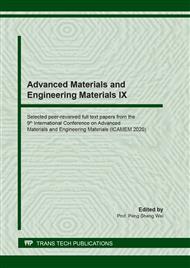[1]
J. Demin, P. Ana, S. Cuib, F. Xuc, T. Tuoa, J. Zhanga, H. Jianga, Effect of leaf fiber modification methods on mechanical and heat-insulating properties of leaf fiber cement-based composite, J. Build. Eng. 19 (2018) 573-583.
DOI: 10.1016/j.jobe.2018.05.028
Google Scholar
[2]
M. Abdelmouleh, S. Boufi, M. Belgacem, A. Duarte, A. Salah, A. Gandini, Modification of cellulosic fibers with functionalized silanes: development of surface properties, Inter. J. Adh. Adhe. 24 (2004) 43-54.
DOI: 10.1016/s0143-7496(03)00099-x
Google Scholar
[3]
J.L. Pehanich, P.R. Blankenhorn, M.R. Silsbee, Wood fiber surface treatment level effects on selected mechanical properties of wood fiber-cement composies, Cem. Con. Res. 34 (2004) 59-65.
DOI: 10.1016/s0008-8846(03)00193-5
Google Scholar
[4]
L. Pimentel, A. Beraldo, H. Savastano, Durability of cellulose-cement composites modified by polymer, App. Eng. Agric. 26 (2006) 344-353.
Google Scholar
[5]
K. Bilba, M.A. Arsenem, Silane treatment of bagasse fiber for reinforcement of cementitious composites, Composites; Part A. 39 (9) (2008) 1488-1495.
DOI: 10.1016/j.compositesa.2008.05.013
Google Scholar
[6]
M. Ardanuy, J. Claramunt, R. Arevalo, F. Pares, E. Aeacri, T. Vidal, Nanofibrillated cellulose (NFC) as a potential reinforcement for high performance cement mortar composites, Bioresource. 7 (2012) 3883-3894.
Google Scholar
[7]
M.T. Postek, R.J. Moon, A.W. Rudie, M.A. Bilodeau, Production and Applications of Cellulose Nanomaterials, TAPPI press, USA (2013).
Google Scholar
[8]
S.J. Peters, T.S. Rushing, E.N. Landis, T.K. Cummins, Nanocellulose and microcellulose fibers for concrete, Trans. Res. Board of the National Academies, Washington DC, pp.25-28.
DOI: 10.3141/2142-04
Google Scholar
[9]
S. Piti, Use of crumb rubber to improve thermal and sound properties of pre-cast concrete Panel, Con. Build. Mat. 23 (2009) 1084-1092.
DOI: 10.1016/j.conbuildmat.2008.05.021
Google Scholar
[10]
K.A. Paine, R.K. Dhir, Research on new applications for granulated rubber in concrete, Const. Mater. 163 (CM1) (2010) 7-17.
Google Scholar
[11]
K.A. Paine, R.K. Dhir, R. Moroney, K. Kopasakis, Use of crumb rubber to achieve freeze thaw resisting concrete, Con. Extreme Con. 6 (2015) 486-498.
DOI: 10.1680/cfec.31784.0047
Google Scholar
[12]
M.S. Bashar, K.M. Anwar Hossain, J.T. EngSwee, G. Wong, M. Abdullahi, Properties of crumb rubber hollow concrete block, J. Clean. Pro. 23 (2012) 57-67.
DOI: 10.1016/j.jclepro.2011.10.035
Google Scholar
[13]
H.R. Matthew, K.B. Najim, H.J. Christina, Transient thermal behavior of crumb rubber-modified concrete and implication for thermal response and energy efficiency in buildings, Appl. Therm. Eng. 33-34 (2012) 77-85.
DOI: 10.1016/j.applthermaleng.2011.09.015
Google Scholar
[14]
K.R. Ali, M. Dehestani, P. Rahmatabadi, Mechanical properties of concrete containing a high volume of tire-rubber particles, Waste Manage. 28 (12) (2008) 2472-2482.
DOI: 10.1016/j.wasman.2008.01.015
Google Scholar
[15]
J.N. Eiras, F. Segovia, M.V. Borrachero, M. Bonilla, J. Paya, Physical and mechanical properties of foamed Portland cement composite containing crumb rubber from worn tires, Mater. & Design. 59 (2014) 550- 557.
DOI: 10.1016/j.matdes.2014.03.021
Google Scholar
[16]
A. Nadal Gisbert, J.M. Gadea Borrell, F. Parres Garcia, E. Julia Sanchis, J.E. Crespo Amoros, J. Segura Alcaraz, F. Salas Vicente, Analysis behavior of static and dynamic properties of Ethylene-Propylene-Diene-Methylene crumb rubber mortar, Con. Build. Mat. 50 (2014) 671-682.
DOI: 10.1016/j.conbuildmat.2013.10.018
Google Scholar
[17]
Y. Changhui, B. Liu, Y. Zheng, Effects of modification of recycled tire rubber particles on strength of crumb rubber concrete, Annu. Rev. Mater. Res. 27 (12) (2013) 113-116.
Google Scholar
[18]
H. Zhang, G. Mifeng, L. Xiaoxing, G. Xuemao, Effect of Rubber Particle Modification on properties of Rubberized Concrete, J. Wuhan Univ.Technol.-Mat. Sci. Edit. 29 (4) (2014) 763-768.
DOI: 10.1007/s11595-014-0993-5
Google Scholar
[19]
O. Obinna, Effects of surface-precoating and silica fume on crumb rubber-cement matrix interface and cement mortar properties, J. Clean. Prod. 104 (2015) 339-345.
DOI: 10.1016/j.jclepro.2015.04.116
Google Scholar
[20]
D. Qiao, B. Huang, X.Shu, Rubber modified concrete improved by chemically active coatingand silane coupling agent, Constr. Build. Mater. 48 (2013) 116-123.
DOI: 10.1016/j.conbuildmat.2013.06.072
Google Scholar
[21]
G. Trilok, S. Chaudhary, R.K. Shama, Mechanical and durability properties of waste rubber fiber concrete with and without silica fume, J. Clean. Prod. 112 (2016) 702-711.
DOI: 10.1016/j.jclepro.2015.07.081
Google Scholar
[22]
L. P. Rivas-Vázquez, R. Suárez-Orduna, J. Hernández-Torres, E. Aquino-Bolanos, Effect of the surface treatment of recycled rubber on the mechanical strength of composite concrete/rubber, Mater. Struct. 48(9) (2015) 2809-2814.
DOI: 10.1617/s11527-014-0355-y
Google Scholar
[23]
F. Mohammadkazemi, K. Doosthoseini, E. Ganjian, M. Azin, Manufacturing of bacterial nano-cellulose reinforced fiber cement composites, Constr. Build. Mater. 101(1) (2015) 958-964.
DOI: 10.1016/j.conbuildmat.2015.10.093
Google Scholar
[24]
H. Liang, Y. Ma, Q. Liu, Y. Mu, Surface modification of crumb rubber and its influenceon the mechanical properties of rubber-cement concrete, Constr. Build. Mater. 120 (1) (2016) 403-407.
DOI: 10.1016/j.conbuildmat.2016.05.025
Google Scholar
[25]
M. Ardanuy, J. Claramunt, J.A. Garcia-Hortal, M. Barra, Fiber-matrix interactions in cement mortar composites reinforced with cellulose fibers, Cellulose. 18 (2) (2011) 281-289.
DOI: 10.1007/s10570-011-9493-3
Google Scholar
[26]
B.J. Mohr, J.J. Biernacki, K.E. Kurtis, Microstructural and chemical effects of wet/dry cycling on pulp fiber–cement composites, Cem. Concr. Res. 36 (7) (2006) 1240-1251.
DOI: 10.1016/j.cemconres.2006.03.020
Google Scholar
[27]
M. Pommet, J. Juntaro, J.Y.Y. Heng, A. Mantalaris, A.F. Lee, K. Wilson, G. Kalinka, M.S.P. Shaffer, A. Bismarck, Surface modification of natural fibers using bacteria: depositing bacterial cellulose onto natural fibers to create hierarchical fiber reinforced nanocomposites, Biomacromolecules. 9 (6) (2018) 1643-1651.
DOI: 10.1021/bm800169g
Google Scholar
[28]
J. Juntaro, M. Pommet, G. Kalinka, A. Mantalaris, M.S.P. Shaffer, A. Bismarck, Creatinghierarchical structures in renewable composites by attaching bacterial cellulose onto sisal fiber, Adv. Mater. 20 (16) (2008) 3122-3126.
DOI: 10.1002/adma.200703176
Google Scholar


